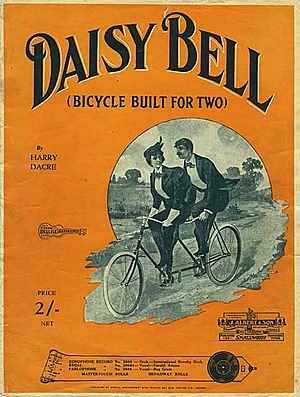Daisy Bell facts for kids
Quick facts for kids "Daisy Bell (Bicycle Built For Two)" |
|
|---|---|
 |
|
| Song | |
| Released | 1892 |
| Genre | Music hall, standard |
| Songwriter(s) | Harry Dacre |
"Daisy Bell (Bicycle Built for Two)" is a very old and famous song from 1892. A British songwriter named Harry Dacre wrote it. The song is well-known for its chorus: "Daisy, Daisy / Give me your answer, do. / I'm half crazy / all for the love of you," which ends with "a bicycle built for two." Some people say the song was inspired by Daisy Greville, Countess of Warwick. She was a friend of King Edward VII. This song is also famous for being the first song ever sung by a computer! An IBM 704 computer sang it in 1961 using speech synthesis. This amazing moment was even shown in the famous movie 2001: A Space Odyssey (1968).
Contents
The Story Behind Daisy Bell
The song "Daisy Bell" was written by Harry Dacre in 1892. A writer named David Ewen shared a fun story about how the song came to be.
How the Song Was Inspired
When Harry Dacre, an English songwriter, first visited the United States, he brought his bicycle. He had to pay a special tax to bring it into the country. His friend, William Jerome, who was also a songwriter, joked with him. He said, "It's lucky you didn't bring a bicycle built for two. Otherwise, you'd have to pay double the tax!"
Harry Dacre really liked the phrase "bicycle built for two." He thought it sounded catchy. Soon after, he used that phrase to write the song "Daisy Bell."
Early Success of the Song
The song first became popular in London, England. A performer named Katie Lawrence sang it in a music hall, which was a type of theater. In the United States, Tony Pastor was the first to sing it. The song became a big hit in America when Jennie Lindsay performed it in New York City in 1892. The first recording of "Daisy Bell" was made by Dan W. Quinn in 1893.
The Song's Lyrics
Here are the words to the famous song "Daisy Bell":
There is a flower within my heart, Daisy, Daisy!
Planted one day by a glancing dart,
Planted by Daisy Bell!
Whether she loves me or loves me not,
Sometimes it's hard to tell;
Yet I am longing to share the lot
Of beautiful Daisy Bell!
Daisy, Daisy,
Give me your answer, do!
I'm half crazy,
All for the love of you!
It won't be a stylish marriage,
I can't afford a carriage,
But you'll look sweet upon the seat
Of a bicycle built for two!
We will go "tandem" as man and wife, Daisy, Daisy!
"Ped'ling" away down the road of life, I and my Daisy Bell!
When the road's dark we can both despise P'liceman and "lamps" as well;
There are "bright lights" in the dazzling eyes Of beautiful Daisy Bell!
(Chorus)
I will stand by you in "wheel" or woe, Daisy, Daisy!
You'll be the bell(e) which I'll ring you know! Sweet little Daisy Bell!
You'll take the "lead" in each "trip" we take, Then if I don't do well;
I will permit you to use the brake, My beautiful Daisy Bell!
(Chorus)
Daisy Bell in Technology and Pop Culture
"Daisy Bell" is not just an old song. It has also played a part in the history of computers and movies!
Computers and Technology
- First Computer Song: In 1961, a large computer called the IBM 704 at Bell Labs was programmed to sing "Daisy Bell." This was the very first time a computer sang a song using speech synthesis, which means making a computer sound like it's speaking or singing. This recording is so important that it's kept in the United States National Recording Registry.
- Floppy Disk Drive Music: In 1985, a programmer named Christopher C. Capon made a Commodore 64 computer program. It made the computer's floppy disk drive (a part that reads disks) play the tune of "Daisy Bell" by moving its parts very fast!
- BonziBuddy: In 1999, a computer program called BonziBuddy could sing "Daisy Bell" if you asked it to. BonziBuddy was a virtual assistant, first a green parrot, then a purple gorilla.
- Cortana: If you ask Microsoft's digital assistant, Cortana, to sing a song, she might sing the first line of "Daisy Bell."
Films
- 2001: A Space Odyssey: The famous science fiction writer Arthur C. Clarke saw the IBM 704 computer sing "Daisy Bell" in 1962. He was so impressed that he put it in his 1968 novel and film, 2001: A Space Odyssey. In the movie, the super-smart computer HAL 9000 sings "Daisy Bell" as it is slowly turned off.
Musical Recordings
Many artists have covered "Daisy Bell" over the years.
- In 2011, a version of the song was included in The Nursery Rhymes Collections Volume 2.
- In 2014, a whole album was released called The Gay Nineties Old Tyme Music: Daisy Bell. This album featured many famous artists singing their own versions of "Daisy Bell." Some of these artists included Katy Perry, Tyler, the Creator, "Weird Al" Yankovic, Nick Cave, Kirk Hammett from Metallica, Mark Mothersbaugh from Devo, Stan Ridgway, and Danny Elfman. The money made from this album went to a charity called Little Kids Rock, which helps kids learn music.
Radio
- In New Zealand, the tune of "Daisy Bell" was used as the opening music for Aunt Daisy's radio shows. Her broadcasts were very popular and ran from 1930 until she passed away in 1963.
See also
 In Spanish: Daisy Bell para niños
In Spanish: Daisy Bell para niños

